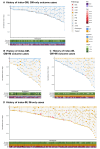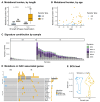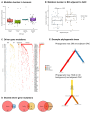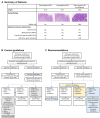Understanding the malignant potential of gastric metaplasia of the oesophagus and its relevance to Barrett's oesophagus surveillance: individual-level data analysis
- PMID: 37989565
- PMCID: PMC11041591
- DOI: 10.1136/gutjnl-2023-330721
Understanding the malignant potential of gastric metaplasia of the oesophagus and its relevance to Barrett's oesophagus surveillance: individual-level data analysis
Abstract
Objective: Whether gastric metaplasia (GM) of the oesophagus should be considered as Barrett's oesophagus (BO) is controversial. Given concern intestinal metaplasia (IM) may be missed due to sampling, the UK guidelines include GM as a type of BO. Here, we investigated whether the risk of misdiagnosis and the malignant potential of GM warrant its place in the UK surveillance.
Design: We performed a thorough pathology and endoscopy review to follow clinical outcomes in a novel UK cohort of 244 patients, covering 1854 person years of follow-up. We complemented this with a comparative genomic analysis of 160 GM and IM specimens, focused on early molecular hallmarks of BO and oesophageal adenocarcinoma (OAC).
Results: We found that 58 of 77 short-segment (<3 cm) GM (SS-GM) cases (75%) continued to be observed as GM-only across a median of 4.4 years of follow-up. We observed that disease progression in GM-only cases and GM+IM cases (cases with reported GM on some occasions, IM on others) was significantly lower than in the IM-only cases (Kaplan-Meier, p=0.03). Genomic analysis revealed that the mutation burden in GM is significantly lower than in IM (p<0.01). Moreover, GM does not bear the mutational hallmarks of OAC, with an absence of associated signatures and driver gene mutations. Finally, we established that GM found adjacent to OAC is evolutionarily distant from cancer.
Conclusion: SS-GM is a distinct entity from SS-IM and the malignant potential of GM is lower than IM. It is questionable whether SS-GM warrants inclusion in BO surveillance.
Keywords: BARRETT'S METAPLASIA; BARRETT'S OESOPHAGUS; GASTRIC METAPLASIA; OESOPHAGEAL CANCER; SURVEILLANCE.
© Author(s) (or their employer(s)) 2024. Re-use permitted under CC BY. Published by BMJ.
Conflict of interest statement
Competing interests: RCF and MOD are named on patents for Cytosponge and associated technology, licensed to Covidien GI solutions (now Medtronic). RCF and MOD are shareholders of Cyted Ltd., a company working on early detection technology. The other authors declare no competing interests.
Figures







Comment in
-
Refining definitions of Barrett's oesophagus to improve clinical resource utilisation.Gut. 2024 Apr 5;73(5):715-716. doi: 10.1136/gutjnl-2023-331458. Gut. 2024. PMID: 38216329 No abstract available.
References
Publication types
MeSH terms
Supplementary concepts
Grants and funding
LinkOut - more resources
Full Text Sources
Medical
